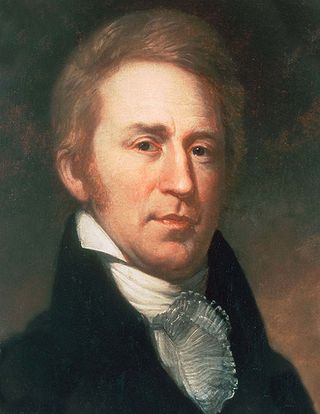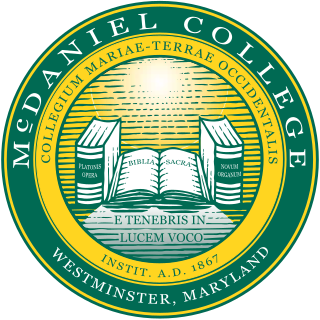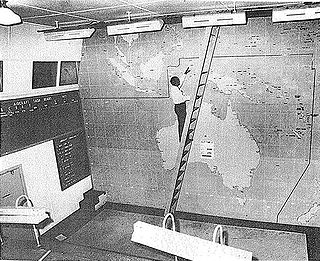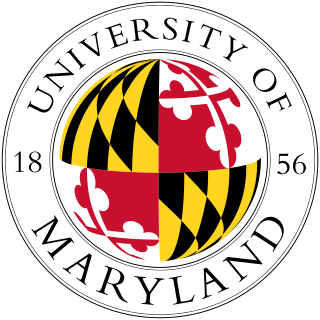Related Research Articles

Grace Brewster Hopper was an American computer scientist, mathematician, and United States Navy rear admiral. One of the first programmers of the Harvard Mark I computer, she was a pioneer of computer programming who invented one of the first linkers. Hopper was the first to devise the theory of machine-independent programming languages, and the FLOW-MATIC programming language she created using this theory was later extended to create COBOL, an early high-level programming language still in use today.

Maryland is a state in the Mid-Atlantic region of the United States. It shares borders with Virginia, West Virginia, and the District of Columbia to its south and west; Pennsylvania to its north; and Delaware and the Atlantic Ocean to its east. Baltimore is the largest city in the state, and the capital is Annapolis. Among its occasional nicknames are Old Line State, the Free State, and the Chesapeake Bay State. It is named after Henrietta Maria, the French-born queen of England, Scotland, and Ireland, who was known then in England as Mary.

Harpers Ferry is a historic town in Jefferson County, West Virginia, United States, in the lower Shenandoah Valley. The population was 285 at the 2020 census. Situated at the confluence of the Potomac and Shenandoah rivers, where the U.S. states of Maryland, Virginia, and West Virginia meet, it is the easternmost town in West Virginia and during the American Civil War was the northernmost point of Confederate-controlled territory. It has been called "the best strategic point in the whole South."

Annapolis is the capital city of the U.S. state of Maryland and the county seat of, and only incorporated city in, Anne Arundel County. Situated on the Chesapeake Bay at the mouth of the Severn River, 25 miles (40 km) south of Baltimore and about 30 miles (50 km) east of Washington, D.C., Annapolis forms part of the Baltimore–Washington metropolitan area. The 2020 census recorded its population as 40,812, an increase of 6.3% since 2010.

Roanoke College is a private liberal arts college in Salem, Virginia. It has approximately 2,000 students who represent approximately 40 states and 30 countries. The college offers 35 majors, 57 minors and concentrations, and pre-professional programs. Roanoke awards bachelor's degrees in arts, science, and business administration and is one of 280 colleges with a chapter of the Phi Beta Kappa honor society.

College Park is a city in Prince George's County, Maryland, United States, and is approximately four miles (6.4 km) from the northeast border of Washington, D.C. The population was 34,740 at the 2020 United States Census. It is best known as the home of the University of Maryland, College Park. Since 1994, the city has also been home to the National Archives at College Park, a facility of the U.S. National Archives, as well as to the National Oceanic and Atmospheric Administration (NOAA) Center for Weather and Climate Prediction (NCWCP) and the Food and Drug Administration (FDA) Center for Food Safety and Applied Nutrition (CFSAN).

Morgan State University is a public historically black research university in Baltimore, Maryland. It is the largest of Maryland's historically black colleges and universities (HBCUs). In 1867, the university, then known as the Centenary Biblical Institute, changed its name to Morgan College to honor Reverend Lyttleton Morgan, the first chairman of its board of trustees and a land donor to the college. It became a university in 1975.

Towson is an unincorporated community and a census-designated place in Baltimore County, Maryland, United States. The population was 55,197 as of the 2010 census. It is the county seat of Baltimore County and the second-most populous unincorporated county seat in the United States.

William Clark was an American explorer, soldier, Indian agent, and territorial governor. A native of Virginia, he grew up in pre-statehood Kentucky before later settling in what became the state of Missouri.

The Second Continental Congress was a late-18th-century meeting of delegates from the Thirteen Colonies that united in support of the American Revolutionary War. The Congress was creating a new country it first named "United Colonies" and in 1776 renamed "United States of America." It convened in Philadelphia on May 10, 1775, with representatives from 12 of the colonies. This came shortly after the Battles of Lexington and Concord and was in succession to the First Continental Congress which met from September 5 to October 26, 1774. The Second Congress functioned as a de facto national government at the outset of the Revolutionary War by raising armies, directing strategy, appointing diplomats, and writing petitions such as the Declaration of the Causes and Necessity of Taking Up Arms and the Olive Branch Petition. All thirteen colonies were represented by the time the Congress adopted the Lee Resolution which declared independence from Britain on July 2, 1776, and the congress agreed to the Declaration of Independence two days later.

Federal Hall is a historic building at 26 Wall Street in the Financial District of Manhattan in New York City. The current Greek Revival–style building, completed in 1842 as the Custom House, is operated by the National Park Service as a national memorial called the Federal Hall National Memorial. The memorial is named after a Federal style building on the same site, completed in 1703 as City Hall.

McDaniel College is a private college in Westminster, Maryland. Established in 1867, it was known as Western Maryland College until 2002 when it was renamed McDaniel College in honor of an alumnus who gave a lifetime of service to the college. The college also has a satellite campus, McDaniel College Budapest, in Budapest, Hungary. McDaniel College is accredited by the Middle States Commission on Higher Education. The college owns and manages a shopping center and residential properties through its for-profit arm.

Brightwood is a neighborhood in the northwestern quadrant of Washington, D.C. Brightwood is part of Ward 4.

Mount Saint Agnes College was a Catholic women's college located in the Mount Washington neighborhood of Baltimore, Maryland. It opened in 1890 and was operated by the Sisters of Mercy. In 1971, Mount Saint Agnes merged with nearby Loyola College in Maryland, which still oversees the Mount Saint Agnes Alumnae Association. The college closed as its own degree-granting institution in 1972.

Bankstown Bunker, formerly known as Air Defence Headquarters Sydney, is a heritage-listed defunct Royal Australian Air Force (RAAF) operations facility, located on the corner of Marion and Edgar Street, in Condell Park, City of Canterbury-Bankstown, New South Wales, Australia. It was designed by Allied Works Council and built from 1943 to 1944 by Stuart Bros Pty Ltd of Sydney. It is also known as Air Defence Headquarters Ruin Sydney (former), No. 1 Fighter Section Headquarters, 1FSHQ, Bankstown Bunker and RAAF No. 1 Installation Bankstown; No. 101 Fighter Sector. It was added to the New South Wales State Heritage Register on 18 November 2011.

The University of Maryland, College Park is a public land-grant research university in College Park, Maryland. Founded in 1856, UMD is the flagship institution of the University System of Maryland. It is also the largest university in both the state and the Washington metropolitan area, with more than 41,000 students representing all fifty states and 123 countries, and a global alumni network of over 388,000. Together, its 12 schools and colleges offer over 200 degree-granting programs, including 92 undergraduate majors, 107 master's programs, and 83 doctoral programs. UMD is a member of the Association of American Universities and competes in intercollegiate athletics as a member of the Big Ten Conference.

The Pentagon is the headquarters building of the United States Department of Defense. It was constructed on an accelerated schedule during World War II. As a symbol of the U.S. military, the phrase The Pentagon is often used as a metonym for the Department of Defense and its leadership.

HagerstownHAY-gərz-town is a city in Washington County, Maryland, United States and the county seat of Washington County. The population of Hagerstown city proper at the 2020 census was 43,527, and the population of the Hagerstown metropolitan area was 269,140. Hagerstown ranks as Maryland's sixth-largest incorporated city and is the largest city in the Panhandle.

The White House to Treasury Building tunnel is a 761-foot (232 m) subterranean structure in Washington, D.C. that connects a sub-basement of the East Wing of the White House to the areaway which surrounds the United States Treasury Building. It was originally constructed in 1941 to allow the evacuation of the president from the White House to underground vaults inside the Treasury in the event of an emergency.

Thomas F. Mulledy was an American Catholic priest and Jesuit who became the president of Georgetown College, a founder of the College of the Holy Cross, and a Jesuit provincial superior. His brother, Samuel Mulledy, also became a Jesuit and president of Georgetown.
References
- ↑ Hull, Sarah (March 31, 2014). "Debunking the Bunker".
- ↑ Graff, Garrett M. (May 2, 2017). Raven Rock: The Story of the U.S. Government's Secret Plan to Save Itself—While the Rest of Us Die. Simon and Schuster. pp. 223–225. ISBN 9781508237877.
- Suchoski, Richard (March 9, 2000). "Basement room of Lewis no longer remains a mystery" (Reprint). Phoenix. Western Maryland College. Retrieved September 18, 2008.
- "The Lay of the Land". The Center for Land Use Interpretation Newsletter. Spring 2000. Retrieved September 18, 2008.